|
Revell's 1/72 Scale
Blohm und Voss Bv 222 V2
by
Chris Wauchop
|
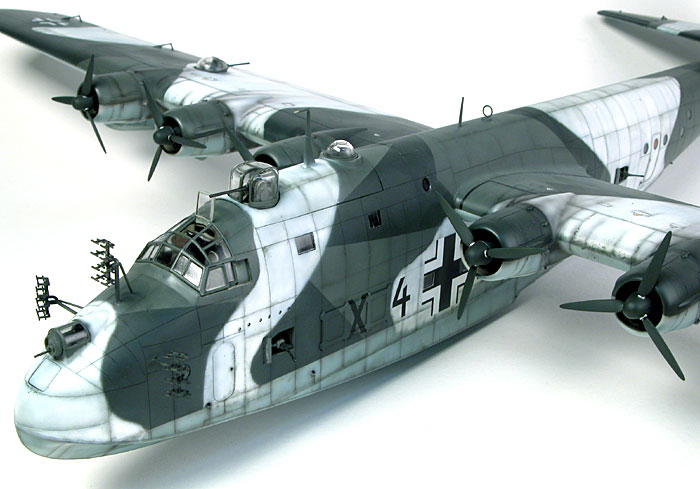
|
|
Blohm und Voss Bv 222 V2 |
images and text by Brett Green

Revell of
Germany's 1/72 scale Bv 222 V2
is available online from Squadron
Here is Revell's 1/72 scale
Blohm und Voss Bv 222 V2 Flying Boat.
The Blohm und Voss Bv 222 V2
changed its appearance frequently during its service. At one stage the
aircraft boasted gondola and rear turrets that were subsequently removed.
The distinctive FuG 200 Hohenentweil arrays bristling from the
front of the Bv 222 were a later addition used for Air to Surface Vessel (ASV)
search.

The unusual
winter whitewash overspray was applied for a specific mission.
Operation
Schatzgraeber was the codename for a mission to rescue the crew of a
remote Arctic weather station who had fallen ill. The initial attempt was
unsuccessful when a Focke-Wulf Fw 200 Condor was damaged on landing. The
Bv 222 V2 was called upon to drop supplies near the station until a second
attempt to lift the crew from their icy station could be staged.
The white paint
was applied to provide some measure of camouflage against the Arctic
landscape.
Chris built
Revell's 1/72 scale Blohm und Voss Bv 222 V2 straight from the box.
This kit is
big. The wing span is greater than two feet, and the fuselage is almost as
long. The sheer size of the kit meant that it was a major construction
project, and the parts breakdown was complex in some areas.
However, the
detail of the kit is very good.
Highlights
include the cockpit and the crew compartment immediately aft. This
cabin contains some very comfortable-looking armchairs, radios, engine
dials, throttles and a big circuit breaker panel. A curtain between the
main cockpit and the crew compartment is also depicted.
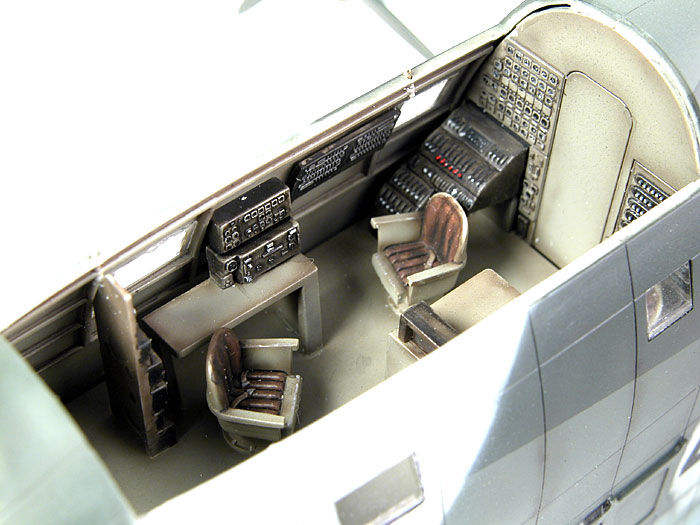
Exterior
surface details are equally nice. Panel lines are crisply engraved. All
six engine nacelles look impressive, and fine detaills include DF loop,
separate actuators for flying surfaces, styrene radar arrays and gun
turrets on the fuselage and in the centre of the wings.
The wing
turrets were the cause for some concern. The clear plastic was noticeably
crazed when it was removed from the sprue. A bath in Future improved their
appearance, but the crazing is still visible.
The fit of the main canopy was not perfect at the top rear
lip despite trimming and test-fitting.
There are a great many individual windows. It is important
to ensure that these windows are securely glued in place, because if they
are accidentally pushed into the fuselage they will be lost forever. This
was the fate of one of the windows while Chris was removing Humbrol Maskol
after painting. Chris used Krystal Kleer to create a new "window" in the
empty space.
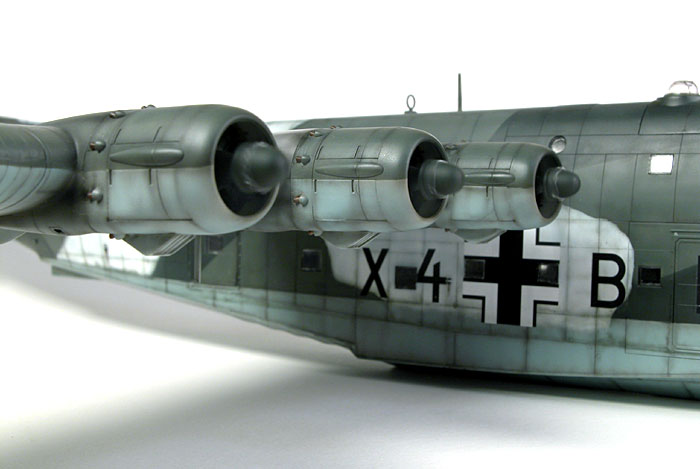
Otherwise, the fit of the kit was extremely good.
Chris commented that the kit is
only let down by the ambiguity of the instructions in places. Some parts
were secured only after trial and error.
The Bv 222 V2
was finished in a standard maritime finish of RLM 72, 73 and 65.
Paints were
custom mixed, starting with Gunze Acrylic RLM 70 Black Green and RLM 71
Dark Green. Each of these colours was lightened and "greyed up" by adding
approximately 20% Tamiya XF-18 Medium Blue The distinction is not
especially obvious when the aircraft is by itself, but the difference is
quite noticeable when placed beside an unmodified 70/71 paint finish.

 All
paints were applied using the Testor Aztek airbrush fitted with the fine
tip. All
paints were applied using the Testor Aztek airbrush fitted with the fine
tip.
The massive aircraft was initially sprayed with unmodified
Gunze RLM 65 Light Blue, followed by the lighter of the upper surface
colours. The splinter camouflage demarcation was masked using Tamiya
masking tape and Post-It Notes - quite a lot of them!
The winter camouflage was a 50/50 mix of Tamiya Gloss
White and Flat White applied very thinly over the base colours. The white
colour was carefully sprayed inside panels and around structural details,
creating the impression of a thin, weathered coat. The irregular pattern
was obtained by masking with skinny rolls of Blu-Tack
Chris followed the camouflage pattern supplied on the kit
instructions, but decided that the starboard scheme did not really look
sensible. He oversprayed his first effort and started again.
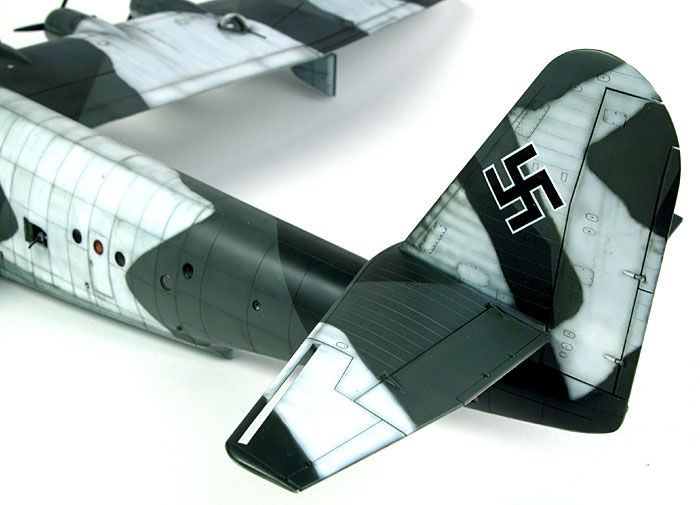
Reference photos suggested that
there was a clear "high water" mark on the lower fuselage, and that the
area below the line was cleaner than the remaining RLM 65 Light Blue
paint. Chris applied some light weathering to the lower section, masked it
off with a straight line of Tamiya Masking Tape and added heavier
weathering to the remaining exposed sections.
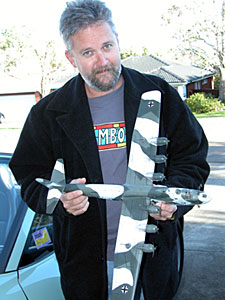
Even though it was a time-consuming project, Chris enjoyed
building and painting this kit and was very pleased with the results.
Revell's 1/72 Blohm und Voss Bv 222 V2 is impressively
big, boasts state-of-the-art structural features and is well detailed. The
FuG 200 arrays are overscale due to their presentation in injection-moulded
styrene, but even these look good from a relatively short distance away
from the kit,
The striking camouflage scheme adds to the overall appeal
of the finished product.
As for the forthcoming Revell 1/72 scale Junkers Ju 290...
Bring it on!
|
Home |
What's New |
Features |
Gallery |
Reviews |
Reference |
Forum |
Search